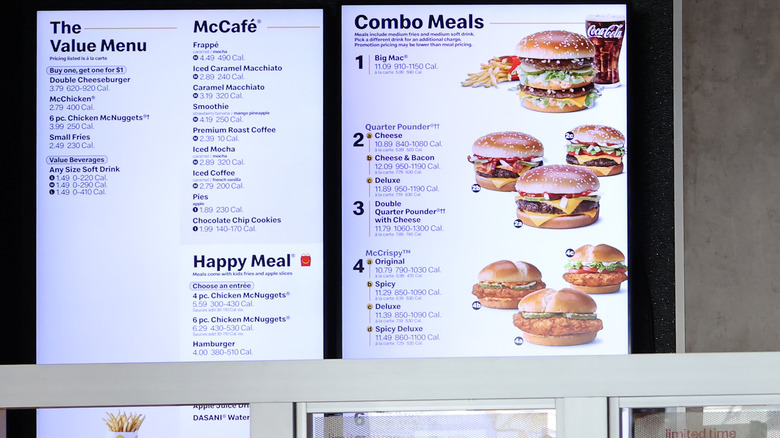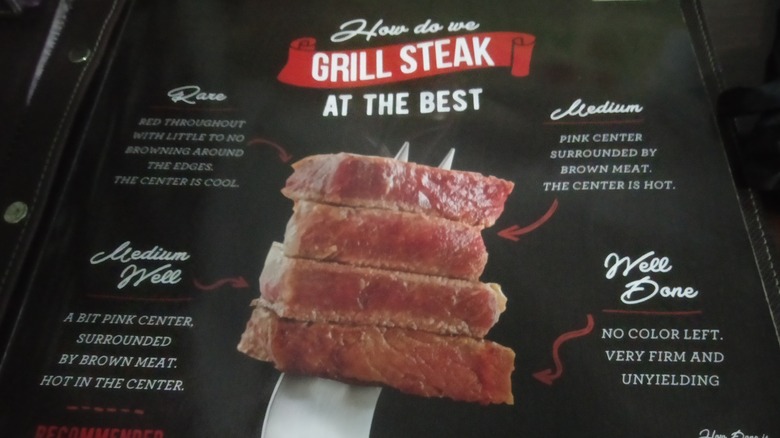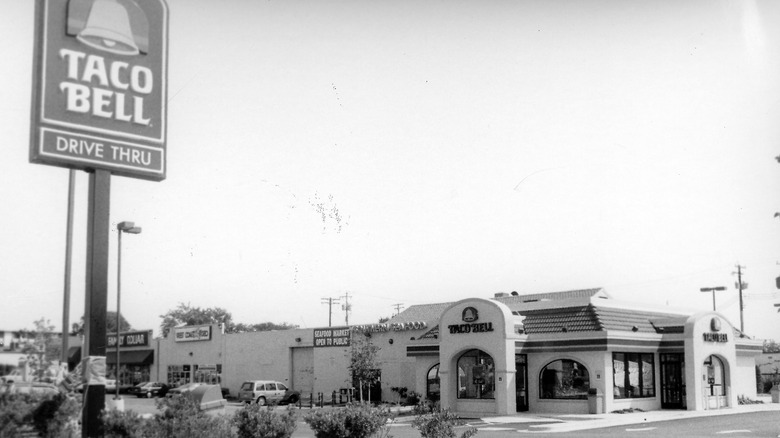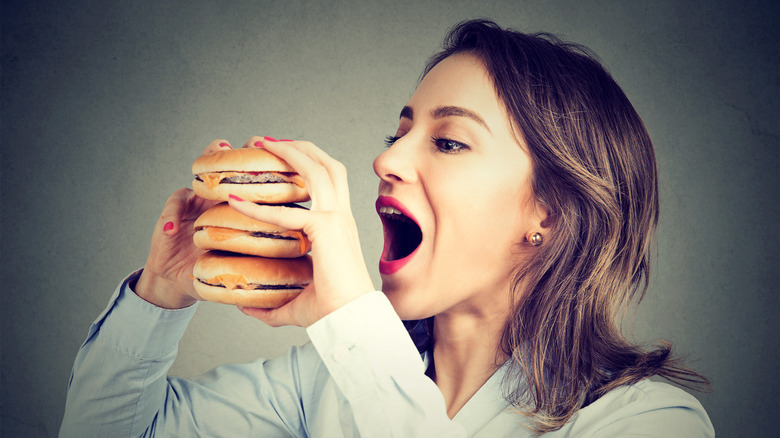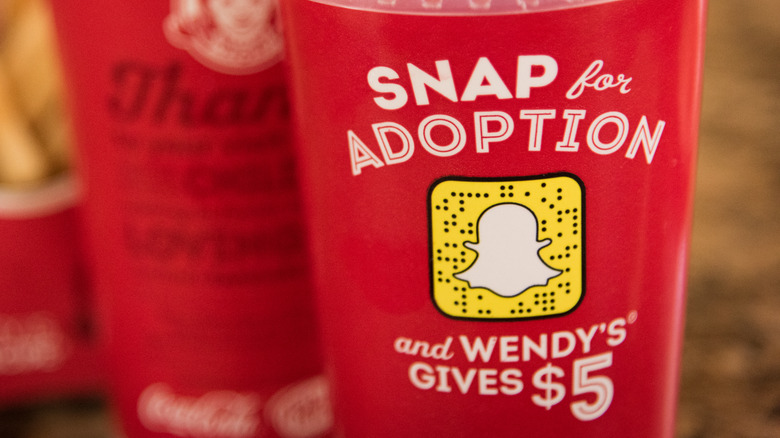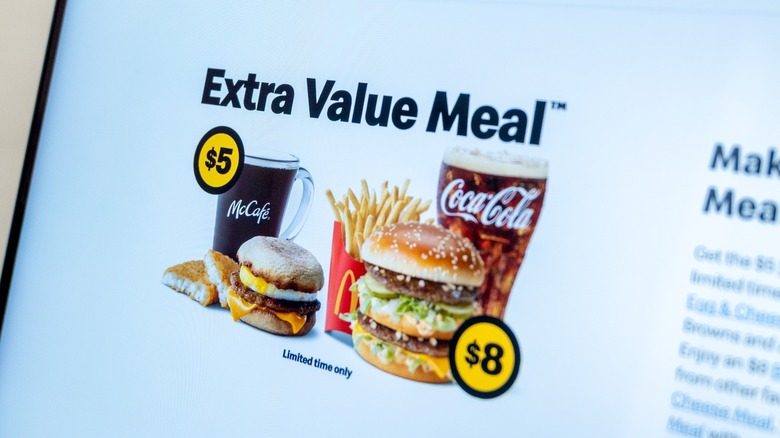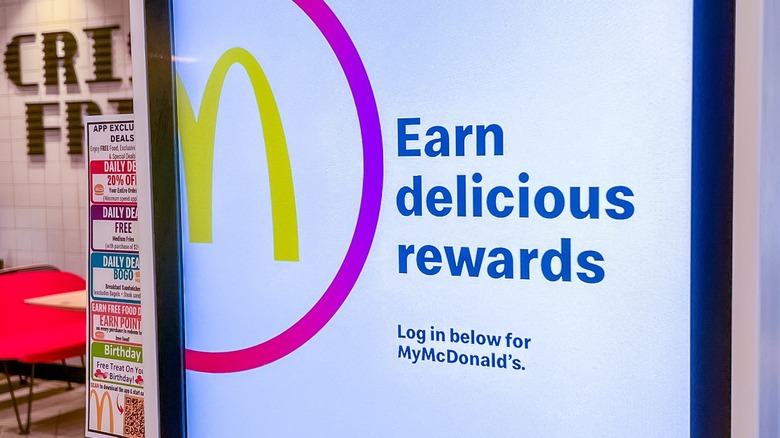Sneaky Ways Fast Food Chains Trick You Into Spending Money
It's no secret that Americans enjoy fast food. Drive down any main road in the United States — whether in a bustling city or a tiny town — and you're bound to see a lineup of various fast food joints. In total, Americans spend a whopping $350 billion on fast food annually, according to Statista, and that trend is only rising. That works out to around $1,200 annually per person. For perspective, homeowners spend around $21,400 yearly on their homes. With the majority of people visiting a fast food restaurant one to three times per week, its easy to see how the spending can get out of hand.
These figures might seem unrealistic, especially given the assumed affordability of quick-service chains. However, the good ol' days of dirt-cheap fast food are over. These restaurants have been hiking their menu prices to keep up with inflation. That's not the only reason you're spending more than you realize, though. Many chains employ behind-the-scenes strategies to get customers to buy more. These tactics seem to be working even as costs skyrocket. Keeping an eye out for these sneaky ways fast food chains trick you into spending money can help you rein in your food budget.
No dollar signs
Have you ever noticed a fast food menu without dollar signs? That wasn't a mistake. It's a subtle technique to keep customers from focusing too much on prices. A Cornell study discovered that diners are inclined to spend more when menus don't include dollar signs. Researchers placed three different menus in front of over 200 participants. One menu included the "$" symbol, another spelled out "dollars" after the number, and the third included the price's numerical digits. Patrons with no dollar signs on the menu spent around 8% more than the others, indicating a significant difference.
While that might not seem egregious for a single outing, those more-than-anticipated costs add up over time. Researchers attributed the decrease in spending to the negative association people have with the dollar sign. People often connect these symbols with the toll of giving away hard-earned dollars. If you're trying to tackle impulse spending effectively, keep this study in the back of your mind. Realize that those numbers you see on the menu translate to actual dollars you'll lose in exchange for food. With that perspective, you may find that the hamburger combo doesn't look quite as appetizing.
Enticing descriptions
Fast food joints aren't tossing random text onto their menus. There's an entire science behind how restaurants convey their food items to customers, as juicer descriptions can literally lead to more spending. Research has demonstrated that foods with a description sell better than those without labels, but the connection doesn't stop there. A study conducted by Cornell Food & Brand Lab at Cornell University, published by ResearchGate, revealed that certain words or phrases can directly influence how much consumers spend. More specifically, the investigation uncovered that descriptive labels can increase sales by a whopping 27%, but the positive repercussions didn't stop there.
These detailed descriptions were proven to entice customers to try food options for the first time by proactively generating interest in a novel item. However, the research also showed how these captivating labels can lead to repeat sales. Cornell researchers report that participants were more likely to judge the foods with evocative descriptions to have a higher value and better quality than competing options. Put another way, they were more likely to overspend on items with good descriptions than those with lackluster or nonexistent labels. It's implausible to visit a fast food restaurant without reading the labels, but keep this effect in mind next time you start salivating after a well-written description.
Combo pricing
If you've ever purchased a combo meal and assumed you're getting more bang for your buck, you've fallen victim to another sneaky fast food chain trick. Mathematically, you will most likely spend less overall on ombo offers than paying for each item individually. Chains commonly discount sides, such as fries or a drink, if purchased alongside an entree. However, the trick is that bundle pricing has been proven to increase how much consumers spend overall. According to the Harvard Business Review, 87% of customers ordered a bundled meal at a fast food joint over a three-month span. These combos encourage people to eat out more frequently and are even effective enough to push diners to visit a new chain.
Consumers may only get a 5% discount on their total meal, but the appeal of the combo by itself is enough to trigger a purchase. A study by Coca-Cola uncovered the deep-rooted impact of this bundle pricing on spending, demonstrating that nearly half of people would still order combos even if they knew there were no discounts attached. Researchers point to the natural connection people make between fast food entrees and sides when explaining why this upcharge is so common. You can add combo meals to the list of things frugal people will always refuse to buy.
Nostalgic or familiar language
Nostalgia is a powerful force in human actions, even impacting how much money people spend at fast food joints. Science Direct has focused research on how this complex human emotion influences spending behavior. Although nostalgia is a multifaceted social phenomenon, the connectedness it elicits is among its most potent aspects in terms of influencing people. Fast food restaurants cash in on this emotional reaction by trying to elicit feelings of nostalgia in customers through clever marketing, targeted language, restaurant layouts, color schemes, and various other visual and auditory touchpoints. These companies pay professional marketers to make customers associate their food with home-cooked meals, outings with friends, family get-togethers, and familiar social experiences in general. Some common phrasiology used by fast food joints to elicit nostalgia and familiarity include traditional, Grandma's, and home-cooked.
Some fast food names are so ingrained in the public consciousness that they can pull from customers' direct experience with their brand. There are several examples of extremely popular, household fast food joints that have drawn upon their long-term familiarity to drive sales. In 2019, Pizza Hut reintroduced its retro logo for a limited period. Taco Bell recently reintroduced five old-school 2000s favorites from the past in a revamped "Decades Y2K Menu." Other chains lean heavily on nostalgia more generally, seeking to create a familial, intimate atmosphere. Cracker Barrel is a prime example of this constant focus on social connectedness. McGraw-Hill Education describes the "iconic American restaurant" as maintaining a "nostalgic country store atmosphere" that consistently reminds patrons of a "bygone era."
Supersized options
McDonald's coined the concept of supersizing in the 1980s in a series of advertisements encouraging customers to order a large portion of fries and a drink instead of a small or medium. While the fast food icon may have coined the phrase, the practice has been in use for a long time. All fast food chains practice this sneaky strategy to get customers to spend more in one form or another. Generally speaking, this sales technique is known as decoy pricing.
Fast food chains will make the price differences between their two smallest options negligibly less than their largest size, encouraging people to opt for their most expensive choice. That 50-cent difference might be a wash for you, but the profits add up over time, considering the number of customers fast food chains attract annually. ResearchGate suggests that the average person will consume 35% more when doubling their portion size, leading to more profits for fast food chains. This supersizing technique does have some limitations, however. Studies indicate that the larger the jump in portion size, the less likely customers are to make the jump.
Virtual impulse buys
Another sneaky way fast food chains trick you into spending more money is by tapping into the "cashless effect." According to Investopedia, this psychological phenomenon causes people to overspend when using virtual forms of payment as opposed to cash. Whether using a credit card or a mobile app, people tend to exercise less financial discretion when using fully digital payment systems. When you use cash, you're physically parting with your hard-earned money. On the flip side, using a plastic credit card or tapping a few buttons on your phone feels less tangible. Fast food chains take advantage of that financial hastiness by expanding their digital footprint and accepting more forms of payment.
Most reputable fast food restaurants have mobile apps where you can complete an order without taking out your wallet. Even places without a dedicated app are available on food delivery apps, which further erode conscious spending habits. Some chains attempt to duplicate the heightened spending that comes with app usage in physical stores by erecting those massive digital pay stalls. Essentially, these stores are looking for ways to make it as convenient and seamless as possible for customers to spend money. And, they're getting exceptionally good at it. At this point in the digital era, one of the top strategies for tackling impulse spending effectively is to pay with cash in person.
Free add-ons or rewards
The old adage about nothing truly being free rings true for fast food places. Many chains dangle the promise of something "free" for customers that reach an arbitrary spending threshold or buy a certain number of items. For example, a burger joint might run a special where customers can get their 10th burger for "free" or maybe another fast food chain doesn't charge for a third side. Studies have shown that these bonus offers don't only get costumers to visit again and again. They also increase how frequently customers spend money, a phenomenon known as purchase acceleration.
A Columbia Business School study showed that people will visit a restaurant more often given the allure of a "free" reward. Furthermore, they'll increase their frequency of visits the closer they get to achieving this goal. It transforms the process from a typical visit to a fast food joint to a gamified experience complete with levels, challenges, and a final prize. Instead of losing interest after getting the "free" perk, customers were shown to pursue the goal again. Keep this in mind next time you're handed a card with punchholes and the promise of a cost-free item.
Hiding cheap options
The popular myth of hidden menus at fast food joints has some basis in reality. The fast food chains with the best value meals don't often advertise their cheapest choices. Practically speaking, chains often omit some of their various food choices to prevent their menus from looking cluttered, usually prioritizing the best-selling candidates. However, there's also a profit motive involved. Many restaurants will purposefully hide their more affordable food choices, while placing the more expensive items in a prominent position. Sometimes, these economical options will be hidden in finer print in the corner of a menu, or they'll be completely left off the menu altogether.
Taking your time to peruse the entire menu before ordering can help save you significantly when the cashier rings up your bill. If you're unable to find anything resembling an affordable meal on the board, ask for a complete menu. Often, fast food chains have complete menus printed out when everything can't reasonably fit on the screen. Although many chains, such as McDonald's and Burger King, are simply unable to maintain their highly popular dollar menus, many still offer items for a few dollars. You just have to be willing to take a few minutes to pinpoint these hidden deals to keep yourself and your wallet full.
Social media presence
You know creators are making money on social media platforms, but you might be surprised to hear the most popular fast food brands are doing the same. Social media isn't usually the first type of outreach consumers think about when considering fast food marketing. However, presence on these platforms has become essential to success in the 21st century, where the attention economy is fractured and people are bombarded with stimuli minute by minute. One ResearchGate survey found that 81% of fast food consumers follow chains on networking platforms such as Instagram, X, and Facebook.
Research has gone as far as to establish a direct link between this virtual engagement and physically visiting a location. Experts indicate that around 41% of people are prompted to patronize a fast food joint after seeing the brand's post on social media. Around a quarter of the population reports always visiting following this interaction. These highly active social media users often post about their positive experiences on social media, creating a chain reaction of publicity for fast food companies. Research has further indicated that fast food brands that opt out of social media usage are falling behind the competition.
Limited-time deals
Ever wonder why fast food restaurants don't keep deals permanently, allowing them to expire after a fixed period? To encourage you to spend more money, of course. Limited-time offers create a sense of urgency, pushing consumers to buy a particular product quickly. Whether it's a day, week, month, or entire season, the timelines are completely arbitrary. They're only set up to give people a fear of missing out. These special deals also provide patrons with a feeling of status and accomplishment. The mere fact that not everyone will be able to take advantage of the offer elicits a perception of value.
The numbers don't lie. Restaurants that utilize a limited-time deal experience a notable surge in patrons and revenue, meaning these special offers attract more people and increase spending. Consider that 70% of people report having purchased a time-sensitive food item in the past month alone. For fast food joints, the payoff from these special offers extends far beyond their set period. Studies have found that 85% of customers who liked the meal will visit again. Furthermore, three out of every four of those people will spread the word to another person.
Loyalty programs
According to Owner, loyalty programs are most profitable for restaurants that attract repeat customers, accommodate virtual orders, and experience a high volume of traffic. Fast food chains fit this description perfectly, making them a perfect and profitable fit for rewards programs. This is evidenced by the prevalence of loyalty programs in the industry, with most fast food brand names offering some version of customer rewards. Deliverect claims that loyalty programs can boost consumer spending by 24%. The financial return of these loyalty programs isn't nominal, either. When operated successfully, they can generate a solid chunk of overall sales, creating a dependable and self-sustaining income for chains. For example, Starbucks reports that 57% of its revenue is generated from rewards members.
As their name suggests, these loyalty programs excel in driving repeat purchases by focusing on rewarding routine visits. It creates a win-win situation where customers unlock rewards in the form of discounts, and fast food chains create an incentive for customers to visit more frequently and spend more. The resulting positive feedback loop keeps generating perks for customers and profits for companies. On paper, patrons are getting tangible discounts on their final bills, but the offered perks are a sneaky way for fast food chains to trick them into spending more. Looking to join your favorite restaurant's loyalty program? Check to see if it has a dedicated app — the most common enrollment method. Others have customers sign up through fast food receipts or through menu QR codes, so be on the lookout.
Charge for sauces
Many fast food chains are beloved for their signature sauces. Whether you're partial to Taco Bell's hot sauces, Chick-fil-A's honey mustard, or Burger King's zesty sauce, it's undeniable that the popularity of these add-ons rivals that of name-brand entrees. A few years ago, it seemed that every chain honored an open season on their sauces, treating customers to a complete free-for-all. Now, customers only find a handful of packets in their bag and risk racking up extra costs when requesting more than the standard amount. It might seem random and even petty, but there are several reasons why restaurants are charging money for extra condiments lately.
Primarily, fast food joints are looking to increase their profit margins by cutting back on the losses associated with customers abusing free sauces. This seems unreasonable when looking at the cost on a per-packet basis, yet restaurants are ordering their sauces in massive bulk orders. Cutting this expense down even moderately can help improve the monthly profit-loss statement. While the majority of customers will overlook a 20-cent packet of sauce, that spending adds up over time for fast food companies when considering their sheer number of patrons. Another reason these brand names are charging for sauces is to cut down on food waste, for which the fast food industry has received criticism over the years.

